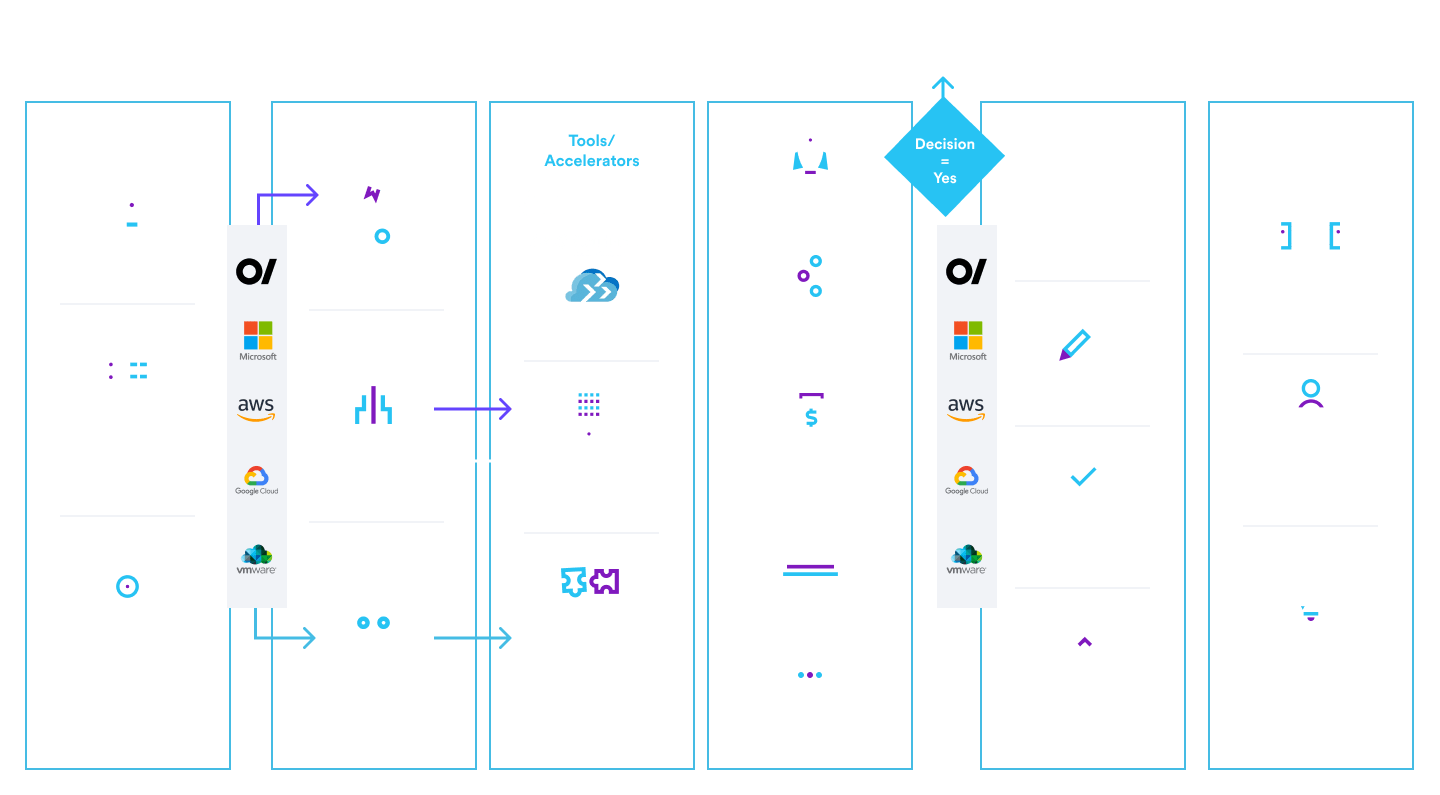Cloud adoption, migration, and transformation are critical journeys that enterprise leaders need to have holistic visibility to drive accountability and make critical decisions for realizing business value cases to see return on investment.
Cloud migration involves critical decisions for enterprise leaders, technical considerations include application compatibility, data security, and performance optimization. Enterprise eco-system need to include change management and skill development. Cost management and compliance are crucial.
Cloud Migration and transformation have various challenges, from non-intrusively completing multi-dimensional technical and non-technical discovery to executing assessment, planning migration waves, and sequencing to seamlessly drive migration and cut over. Traditionally enterprises leveraged siloed discovery & migrations tools for hyperscaler-specific migrations, complicating and expanding the migration toolset with none of the tools providing end-to-end visibility to executives.
Cloud Transformation Hub offers end-to-end visibility and operational capabilities, aiding decision-making and tracking migration progress. It centralizes information, streamlines collaboration, and ensures successful cloud migration, being able to realize business case to return on investment. its a comprehensive platform that facilitates end-to-end cloud migration journeys, regardless of the target cloud hyperscaler of choice. It is an integral part of Orion’s cloud adoption framework (CAF) and incorporates industry best practices derived from enterprise workload migrations.

Key Features of Cloud Transformation Hub
Business Goals: Establish clear objectives for the migration process, aligning it with the overall business strategy.
Infrastructure and Application Assessment: Evaluate the current state of your IT infrastructure and applications to determine their readiness for migration.
Strategic Decision Making: Leverage Orion’s subject matter experts (SMEs) and the Cloud Transformation engine to make informed decisions regarding the 6R strategy (Rehost, Refactor, Rearchitect, Re-platform, Retire, Retain).
Cloud Environment Selection: Choose the optimal combination of public and private clouds aligned to you enterprise transformation journey
Application & Data Migration: Migrate data and applications in a phased approach, ensuring minimal disruption to operations.
Security and Compliance Management: Maintain robust security measures and ensure compliance throughout the transformation process.
Monitoring and Optimization: Continuously monitor and optimize the cloud-based solution to enhance performance and cost efficiency.
Integration and Customization: Seamless integration with market-leading tools or partner tools already utilized within your organization, allows for customization and tailoring of the platform to meet your specific needs and requirements.
With Cloud Transformation Hub’s Orion migration journey, you gain the ability to make critical decisions, implement security and compliance measures, and execute automated migrations. Take advantage of its features to streamline and optimize your cloud migration process.
Discovery: By utilizing a combination of automated processes and manual interviews, as well as surveys of stakeholders, along with comprehensive analysis and assessment of collected data using AI models, the Cloud Transformation Hub (CTH) will acquire the necessary information regarding the application landscape, associated dependencies, and networking requirements. The Discovery phase encompasses both technical and non-technical assets and dependencies that fall within the scope of migration.
Assessment: To plan and establish the target architecture, the Workload Assessment phase focuses on understanding the applicability of the 6Rs (Re-Host, Re-Factor, Re-Platform, Re-Purchase, Retire, Retain) and offers costing and migration recommendations based on customized assessment rules and preferences.
Target Architecture: Through discussions with business units to comprehend their objectives and the short-term and long-term benefits of cloud adoption, the target architecture preferences are defined. Multiple proposals are generated, encompassing options such as re-hosting, re-platforming, re-factoring, etc., accompanied by detailed bill of materials and pricing for cloud services.
Roadmapping: During the Roadmapping phase, the application and its dependencies are meticulously planned in terms of migration waves and sequencing.
Kick off: The workload wave migration is designed to be controlled, enabling both manual and automatic scheduling.
Migration: The Migration phase tracks the status of application migration to the cloud. Prior to the cutover, the migrated application undergoes signoff and validation.
Post Migration: Following the migration, continuous monitoring of the cloud-based application takes place, leveraging the capabilities of the Cloud Transformation Hub (CTH). This includes assessing non-functional aspects and ensuring the proper functioning of application features such as high availability and disaster recovery backup configurations.
Cloud Business Case: A comprehensive comparison of on-premise and cloud costs is presented, providing a clear understanding of the financial benefits of migrating to the cloud.
Summary: The Cloud Transformation Hub serves as a unified platform for organizational leadership, application owners, and migration experts. It offers a consolidated view of the migration process, facilitates assessment and decision-making, and enables the execution of the migration plan.
Learn more about our Cloud & Infrastructure Center of Innovation.